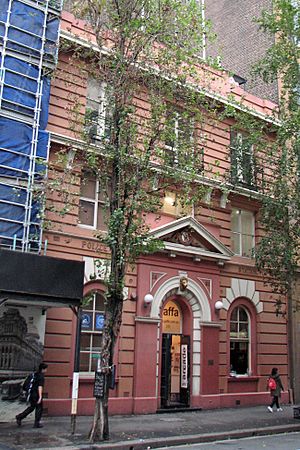Clarence Street Police Station facts for kids
Quick facts for kids Clarence Street Police Station (former) |
|
|---|---|

Former Police Station at 281 Clarence Street, Sydney
|
|
| Location | 281 Clarence Street, Sydney central business district, City of Sydney, New South Wales, Australia |
| Built | 1890–1928 |
| Architect | James Barnet; NSW Government Architect |
| Official name: Police Station (former); Police Station | |
| Type | State heritage (built) |
| Designated | 2 April 1999 |
| Reference no. | 293 |
| Type | Police station |
| Category | Law Enforcement |
| Builders | Unknown |
| Lua error in Module:Location_map at line 420: attempt to index field 'wikibase' (a nil value). | |
The Clarence Street Police Station is a historic building in Sydney, Australia. It used to be a police station and is now an office for community services. Located at 281 Clarence Street in the heart of Sydney, it was designed by a famous architect named James Barnet. The building was constructed between 1890 and 1928. It was officially added to the New South Wales State Heritage Register on 2 April 1999, meaning it's an important part of the state's history and should be protected.
Contents
A Look Back: History of the Police Station
The area around Sydney's docks, like Woolloomooloo and Darling Harbour, was a very busy place. Many people worked and lived there, especially those connected to the ships and port.
Why a Police Station Here?
In the late 1800s, there were big changes happening in society. During the 1890s, times were tough for many workers. There were often disagreements between workers and their employers. The government wanted to make sure there was order and safety in these busy areas. Having a strong police presence was a way to help manage these situations.
The police station at 281 Clarence Street was built in 1891. Its location near the Darling Harbour docks was important. It showed that the government was serious about keeping peace and order.
Building Changes Over Time
The original building was designed by James Barnet, who was the government's main architect. It started as a two-storey building. Later, in 1928, a third floor was added to make it bigger.
The building served as a police station until 1967. After that, it was sold and has been used as office space ever since.
- 1922: More rooms were built at the back.
- 1923: Electric lights were installed for the first time.
- Around 1928: The second floor was added.
- Around 1985: The building was updated. Many parts of the ground floor, including the old police cells, were removed.
- 1992: Additional space was built at the rear.
- 2000: The building had a major renovation.
What the Building Looks Like
The building at 281 Clarence Street is a small, four-storey office building today. You can still see the date "1891" on its front. It has three floors that are similar in size. The top (third) floor is set back a bit, creating a terrace.
Inside, there's an open space called an atrium that goes all the way up through the middle of the building. This helps bring light into the center. The building is made of brickwork, which has been covered and painted. Most floors are made of timber. Interestingly, some rooms on the ground floor, which used to be police cells, have cool arched brick ceilings.
The roof is made of metal, and the atrium roof is made of glass. This glass roof has special louvres that let air and light in. The windows in the building are a mix of old and new styles, including traditional sash windows and modern glass panels. Some windows on the first and second floors open into the atrium.
Why This Building is Special
The former Clarence Street Police Station is very important for several reasons:
Architectural Significance
This building is a great and rare example of a police station from the Victorian era in central Sydney. It was designed by James Barnet, a very famous architect. He designed many important public buildings, like the GPO and the Castlereagh Street Fire Station. The building's design, especially its front, is well-liked and includes additions from 1928.
Historical Importance
The building has a lot of historical value because it's one of the most complete former metropolitan police stations. Even though it's been changed and used as offices, it still tells a story about law and order in Sydney during the 1800s and early 1900s.
Social Value
This old police station shows how important social order was in Sydney during the 1800s. It reminds us of the role police played in keeping communities safe and organized.
The Police Station was added to the New South Wales State Heritage Register on 2 April 1999 because it meets several important criteria:
- It shows how cultural history developed in New South Wales.
It's a rare example of a Victorian Police Station designed by a key government architect.
- It shows high creative or technical achievement.
Its strong Victorian design and Barnet's unique details make it stand out. It provides a nice contrast to the larger, newer buildings around it.
- It has a strong connection with a community or group.
The former Police Station highlights the importance of social order in Sydney's past.
- It can help us learn more about New South Wales' history.
The building has the potential to provide more information about the cultural history of the state.

